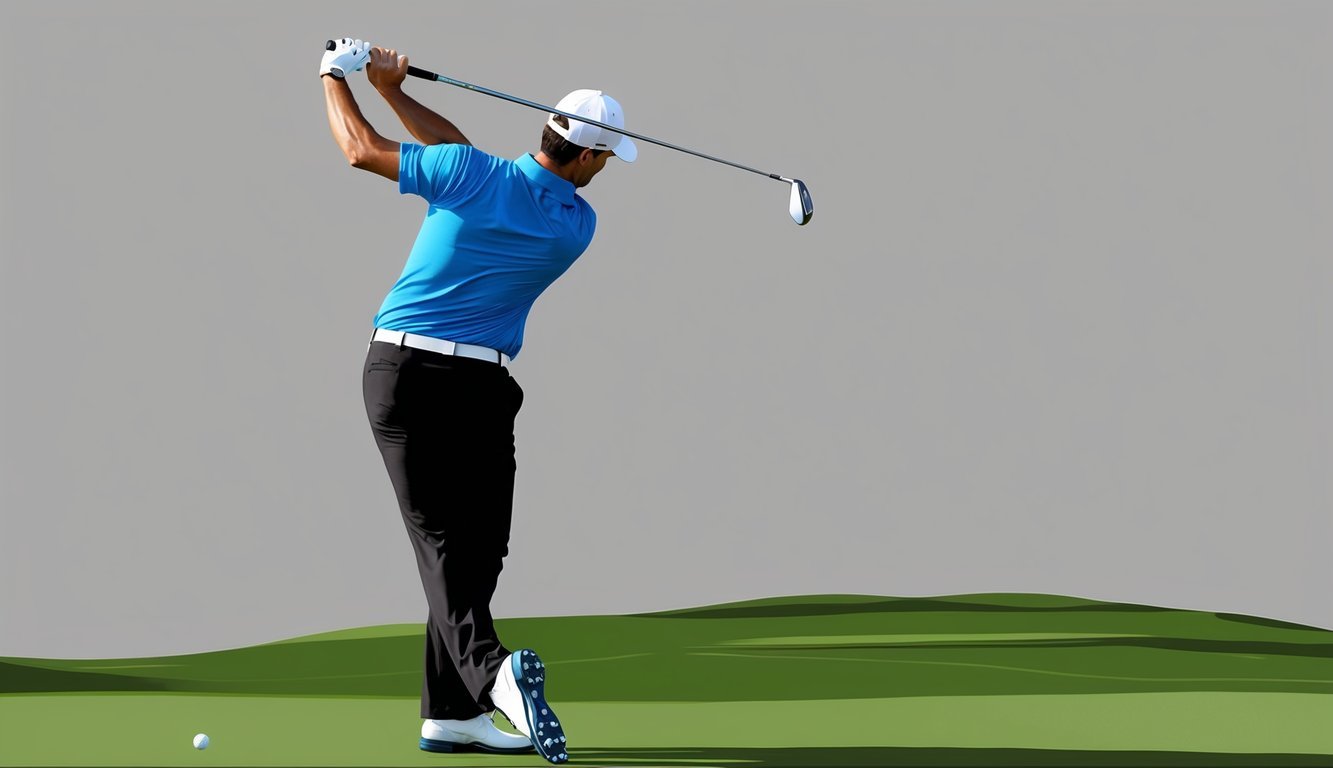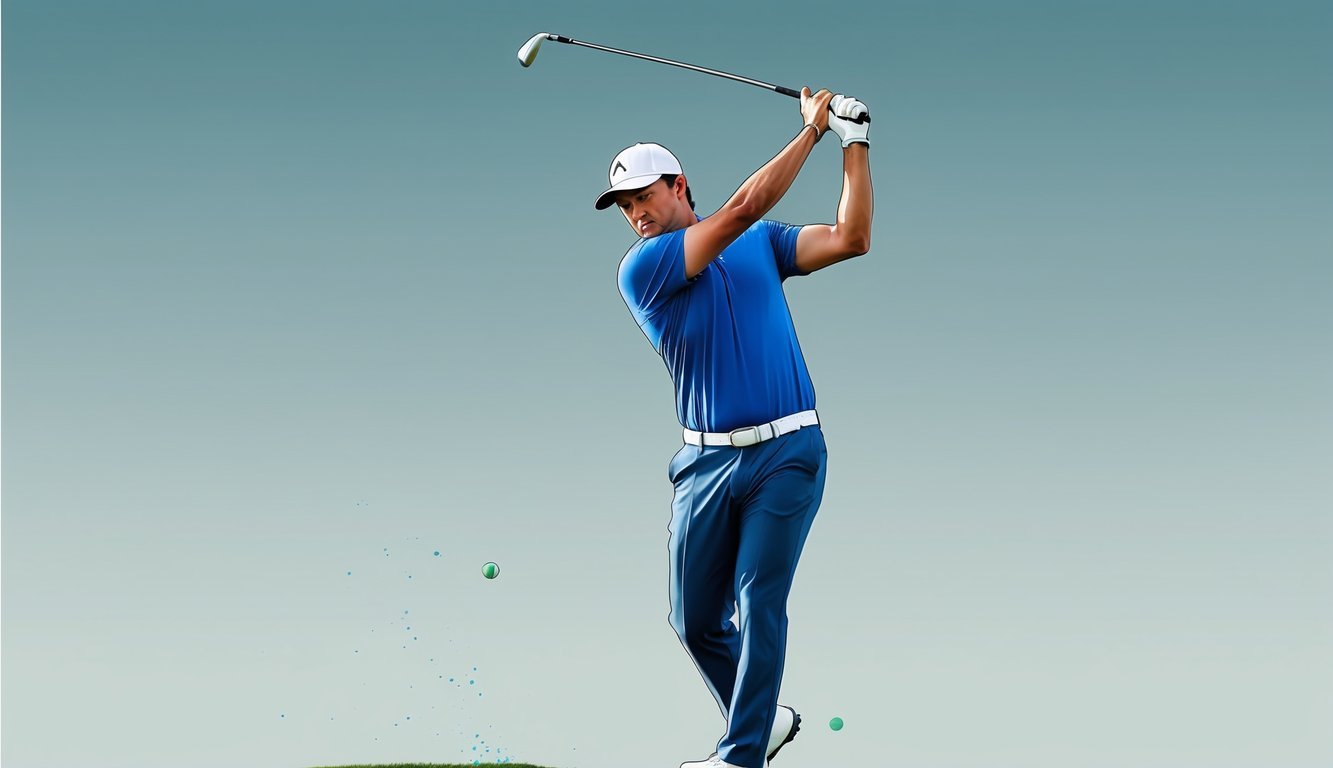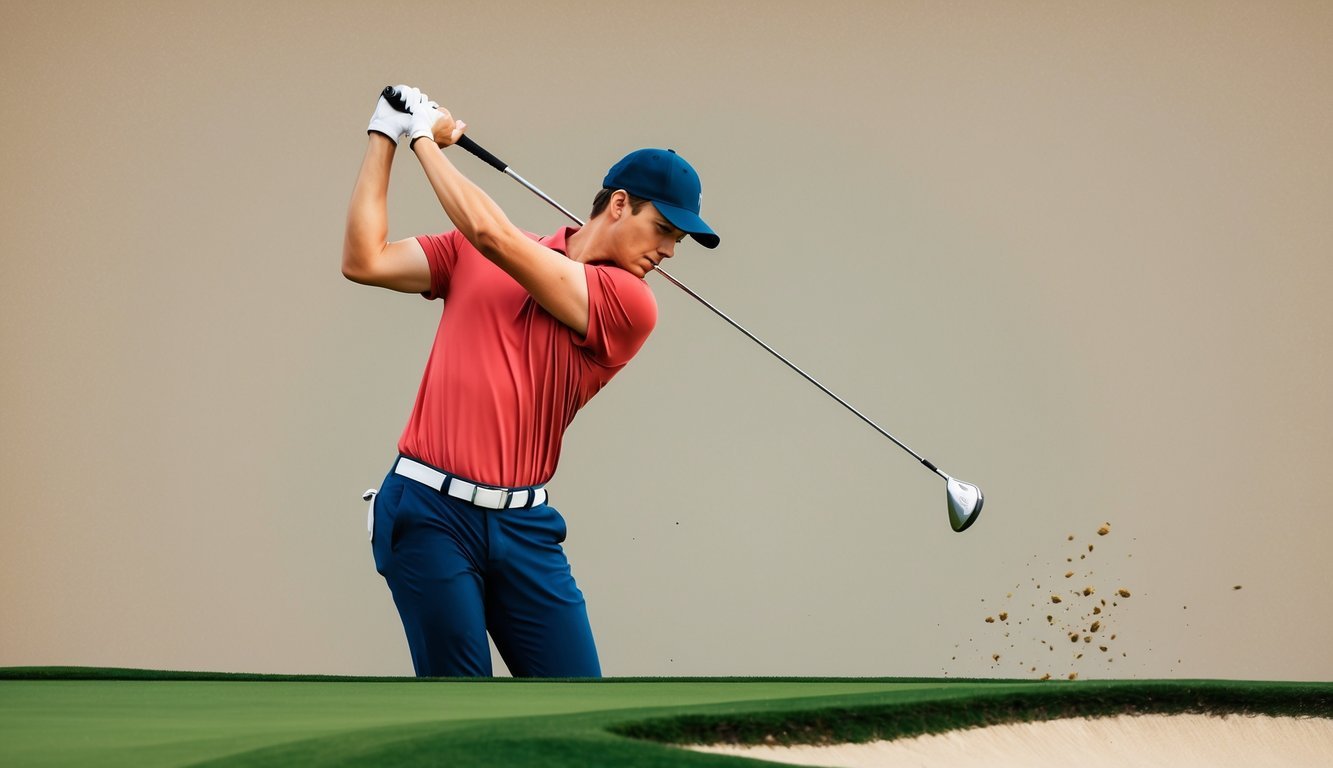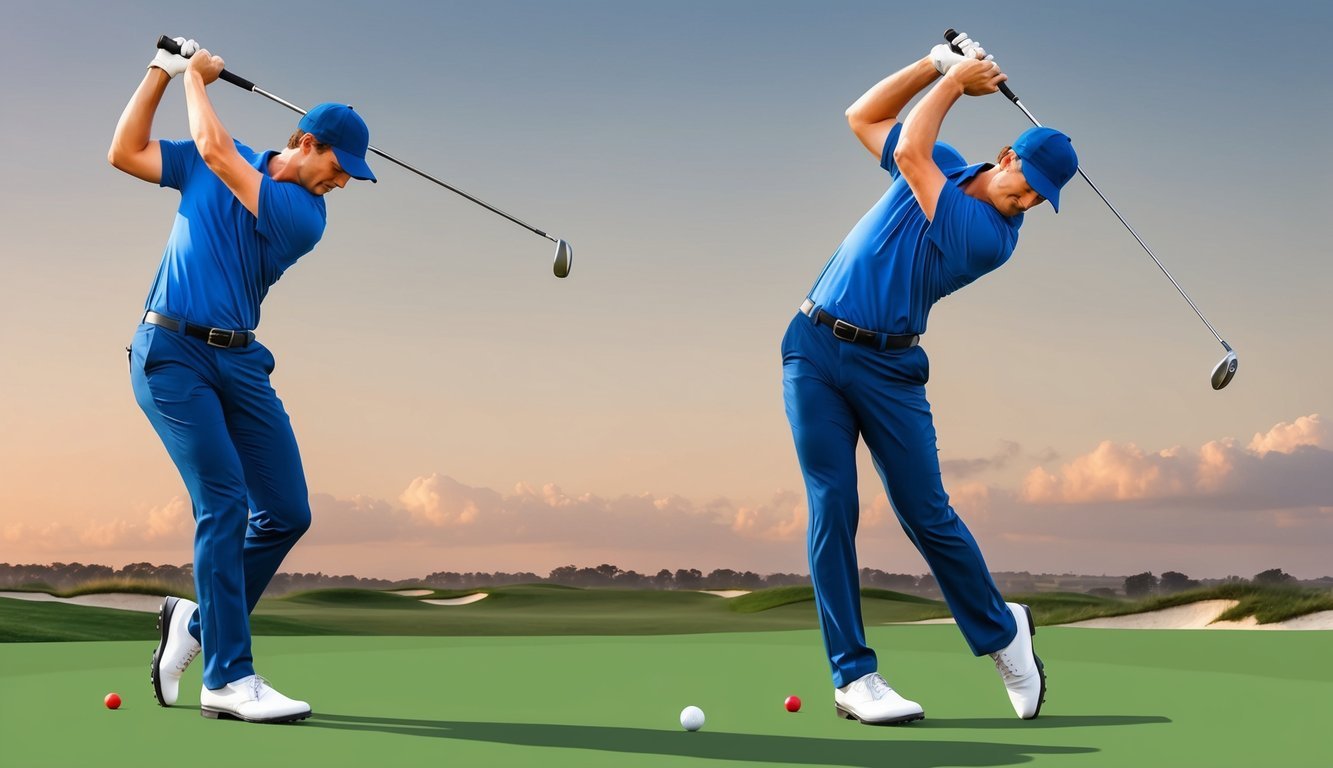Experts often advise maintaining a straight left arm in your golf swing, as it can significantly affect the quality and consistency of your shots. Keeping your left arm straight helps promote a full shoulder turn, which is crucial for power and precision. While some professional golfers achieve a slightly bent elbow, a straight left arm is generally recommended for beginners and intermediates looking to improve their swing fundamentals.

To adopt this technique effectively, you need to focus on the mechanics of your backswing and how your body transitions into the downswing.
This approach not only aids in generating power but also enhances swing stability.
For those eager to refine their performance, mastering how to maintain a straight left arm is a step toward achieving fluidity and control in your golf game.
Consider incorporating practice drills into your routine that emphasize keeping your left arm straight.
Simple exercises can tailor your muscle memory, making it easier to replicate this stance every time you approach the ball.
With dedication and attention to detail, you can see noticeable improvements in your golf swing.
Key Takeaways
- A straight left arm promotes a full shoulder turn.
- Correct backswing mechanics enhance power and control.
- Practice drills are essential for consistent performance.
Fundamentals of a Solid Golf Swing
Mastering a solid golf swing involves understanding the mechanics of your body and equipment.
Focus on the role of your left arm, the swing plane, and the essential grip and setup techniques to enhance your game.
The Role of the Left Arm
The position and movement of your left arm are crucial in achieving a consistent golf swing.
Keeping a straight left arm helps maintain the arc of your swing, ensuring better contact with the ball.
It minimizes erratic movements that might alter the path of the clubhead.
A straight arm doesn’t mean rigid; there should be enough flexibility to allow for a smooth rotation and follow-through.
Try practicing with a slight bend and gradually strengthening your arm over time.
Visualize your left arm as the guiding force, leading your swing path while your right arm provides support and power.
Understanding Swing Plane
The swing plane defines the path your club travels during a swing.
A consistent swing plane is crucial for delivering power and accuracy.
Picture an invisible sheet of glass resting on your shoulders.
Ideally, your club should follow its path throughout the swing.
Misalignments in the swing plane can result in slices or hooks.
To correct this, focus on keeping the club on the targeted path during the backswing and downswing.
Pay attention to your setup and alignment; improper positioning may cause the club to deviate from the ideal path.
Practice drills with alignment sticks to get a better feel for the proper swing plane and develop muscle memory for consistent swings.
Grip and Setup for Success
The foundation of any successful golf swing lies in your grip and setup.
A strong grip provides stability and control, affecting both the direction and distance of the ball.
Ensure your left hand is positioned so the club runs diagonally across your palm, with your thumb pointing down the shaft.
For the setup, ensure your feet are shoulder-width apart.
This grants balance and facilitates proper weight transfer during your swing.
Start with slight knee flex, eye on the ball, and the clubface square to your target.
Address position should feel comfortable and balanced, allowing for a fluid swing motion.
Prioritize practice to refine your grip and setup, as these elements are the foundation of a reliable golf swing.
The Mechanics of the Backswing
In the backswing of your golf swing, mastering the movement of your arms and shoulders is crucial for achieving both distance and accuracy.
A focus on maintaining a straight left arm helps you create width and extension, which enhances the quality of your swing.
Maintaining a Straight Left Arm
Keeping your left arm straight during the backswing is essential for consistency.
This helps maintain the correct swing path and keeps the clubhead on track.
A straight left arm also aids in aligning your shoulders properly, promoting a smoother transition into the downswing.
By ensuring your left arm stays straight, you can prevent unnecessary bending at the elbow, which can lead to loss of power and direction.
It’s the key to preventing muscle strain and enhancing precision.
Think of your arm as a consistent guide that leads your club in a sweeping motion for maximum distance.
Creating Width and Extension
Achieving width and extension in your backswing involves maximizing the distance between your hands and your body.
This is accomplished by emphasizing a full shoulder rotation.
By pushing your hands as far away from your body as you comfortably can, you create a longer swing arc that helps generate more power and speed upon contact.
Extension, paired with a straight left arm, contributes to better shot reliability.
The process allows your arms to fully extend as part of the swing, closing the gap between you and the clubhead.
This connection enhances overall control, setting the stage for a powerful downswing that’s both consistent and precise.
Transition and Downswing Dynamics

Understanding how to transition from the top of the swing into the downswing is key to enhancing your golf game.
This involves maximizing power, speed, and control while maintaining a straight lead arm.
From Top of the Swing to Impact
The transition from the top of the swing is a critical moment where power and speed are built up.
It starts when your left arm is parallel to the ground, driving smoothly towards impact.
Maintaining a straight lead arm throughout this phase can significantly enhance control and accuracy. Body rotation plays a vital role here.
By engaging your hips actively, you help generate momentum.
To avoid tension in the elbow, keep your muscles relaxed but engaged through this transition.
Feel the energy transfer from your legs through your torso, eventually releasing through your arms at impact.
A fluid downswing ensures that the club accelerates consistently, leading to a powerful hit.
Keeping your posture intact maintains the precision needed to strike the ball cleanly and effectively.
Rhythm and timing are essential components that ensure your movement flows naturally from start to impact.
The Importance of the Lead Arm
In the downswing, the lead arm is crucial for control and power delivery.
A straight lead arm helps maintain the right swing plane, aiding both power and precision.
This straight position reduces unnecessary movements and aids in keeping the swing consistent.
Your elbow should be comfortable and not overly tense to facilitate a smooth follow-through.
Straightening the lead arm naturally boosts speed, allowing for a cleaner connection with the ball.
Building awareness of how your arm works in this phase helps to optimize your body rotation, ensuring that each swing is both powerful and efficient.
Finishing with Purpose

To master the art of finishing your golf swing, focus on maintaining a straight left arm and achieving balance.
A solid follow-through and stable finish improve swing speed and momentum, enhancing your overall performance.
Follow-Through and the Straight Left Arm
When you swing, the follow-through is just as critical as the initial parts.
Keeping a straight left arm throughout ensures you maintain the right swing path.
This technique helps in transferring energy effectively, providing more distance and accuracy.
A straight left arm typically leads to a better posture during the follow-through.
A bent arm can lead to a loss of control and power.
Focusing on this allows you to capitalize on the momentum created at impact, making your shots more effective.
Stability and Balance in the Finish
Stability in your finish plays a crucial role in controlling your golf swing.
As you complete the swing, ensure your weight is balanced, primarily on your front foot.
This alignment plays a key role in maintaining posture and swing integrity.
Balance impacts the swing’s consistency.
An unstable finish can lead to erratic shots, while a balanced stance aids in maintaining momentum.
Proper stability can also improve swing speed, helping deliver more power through the ball.
Maintaining a steady stance right after the swing allows for better accuracy and control in every shot, enhancing your performance on the course.
Practice Drills and Exercises

Incorporating specific practice drills and exercises can significantly improve your ability to maintain a straight left arm in a golf swing.
This includes working on your swing arc and building strength and flexibility to support a smooth and controlled movement.
Drills for a Better Swing Arc
Focusing on the swing arc, a renowned method is the split grip drill.
By placing a gap between your hands on the club, you can experience the stretch and rotation essential for an effective swing.
This drill not only aids in maintaining a straight left arm but also helps with body alignment, reducing the likelihood of missing a shot due to collapsing the arm.
Experimenting with training aids like alignment sticks can further refine your takeaway and swing arc, helping you internalize the correct movements.
These aids provide immediate feedback, allowing you to adjust your technique in real-time and build muscle memory, leading to consistent performance on the course.
Strength and Flexibility Training
Sustaining a straight left arm in your golf swing requires strength and flexibility.
You can enhance your body’s overall stability by doing exercises that focus on your shoulders and core.
Consider incorporating workouts like shoulder rotations and plank variations into your routine.
Resistance bands can help you build strength and enhance flexibility.
These bands are versatile tools, perfect for mimicking the motions involved in your swing.
Regular practice with these exercises ensures that your body can support a smooth and controlled motion.
This, in turn, improves your swing consistency and reduces strain on your muscles.

